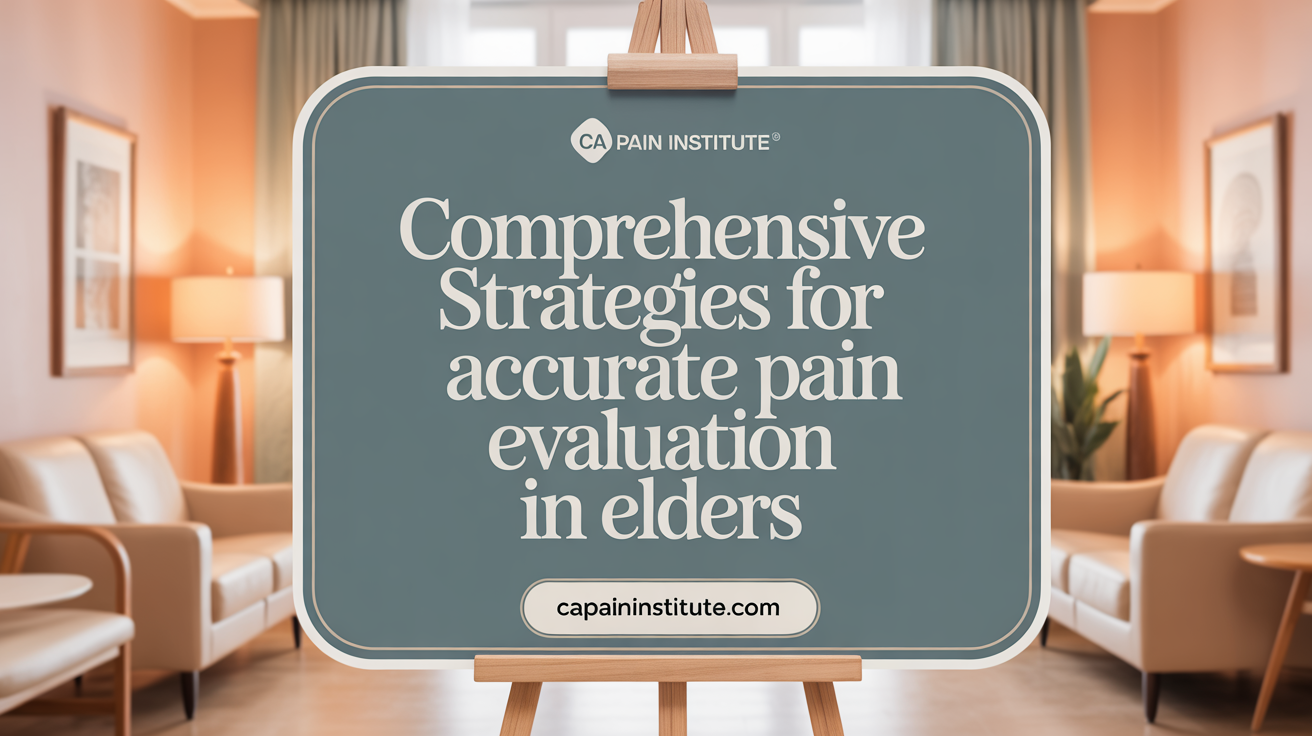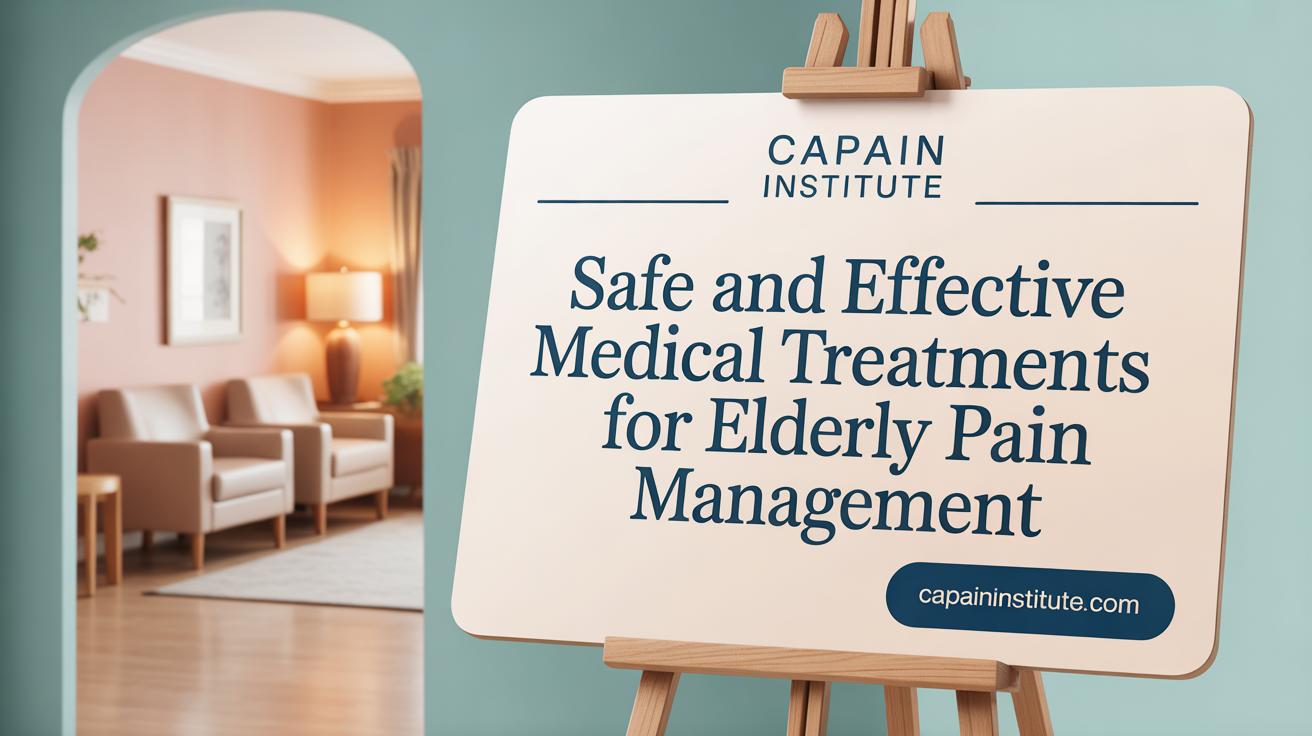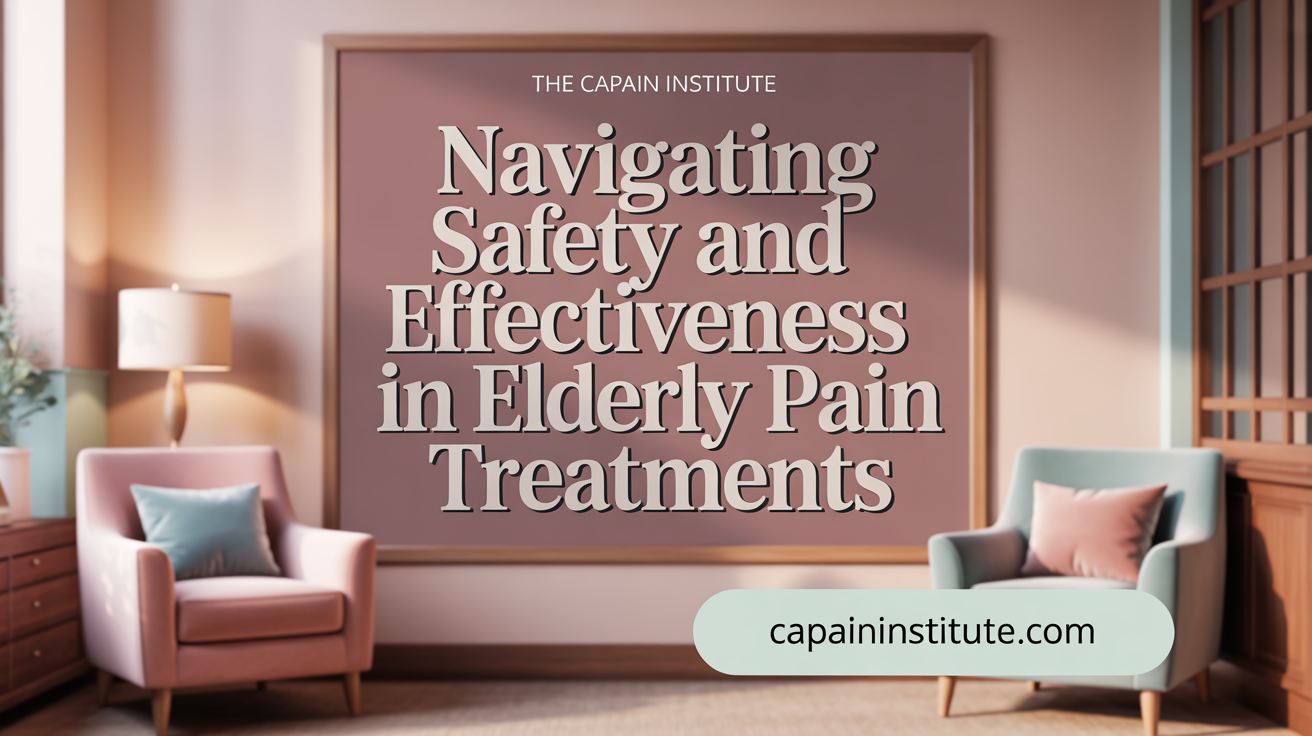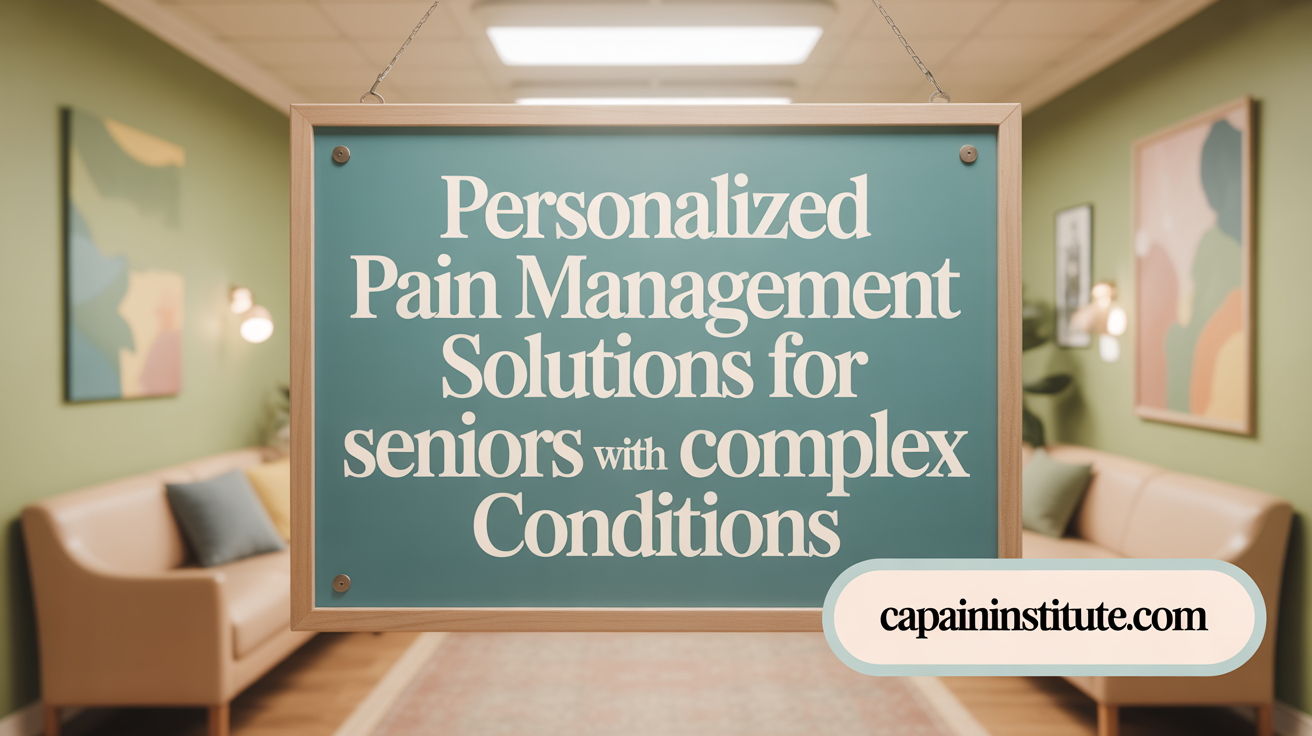Understanding Pain in Seniors
Pain is a common and complex issue affecting a significant portion of the senior population. Its presence can diminish quality of life, reduce independence, and lead to further health complications. Chronic and acute pain in older adults often stems from a variety of causes, requiring sensitive assessment and multifaceted management. This article explores the causes, challenges, and diverse treatment options for pain management specifically tailored for seniors, taking into account the unique physiological and cognitive considerations inherent to this group.
Common Causes and Types of Pain in the Elderly
What are common causes and types of pain experienced by seniors?
Older adults often face a variety of pain sources that significantly impact their daily lives. Musculoskeletal disorders are the most frequent causes, including conditions such as osteoarthritis and degenerative spinal changes, which lead to persistent joint and back pain.
Neuropathic pain is also prevalent, resulting from nerve damage associated with diabetes, shingles, or nerve compression syndromes. Peripheral vascular disease may cause ischemic leg pain, especially during exertion.
Age-related physiological changes influence how pain is perceived, diagnosed, and managed in seniors. These alterations can cause increased sensitivity or, conversely, decreased pain perception, complicating assessment and treatment. For example, decreased neurotransmitter levels and declining organ function may lower pain thresholds, making older adults more susceptible to pain, even at lower stimuli.
Chronic pain often accompanies neurodegenerative conditions like Parkinson’s disease and dementia. As these diseases progress, pain can become more intense and harder to identify due to communication barriers.
Furthermore, mental health conditions such as depression and anxiety frequently coexist with chronic pain, creating a cycle that exacerbates both conditions. Pain not only reduces physical function but also diminishes overall quality of life, leading to social isolation and mood disturbances.
Managing pain in the elderly requires an integrated approach, combining medication, physical therapy, behavioral interventions, and social support. Therapies should be tailored to individual needs, carefully balancing efficacy with safety, especially considering increased sensitivities and comorbidities.
In summary, seniors experience pain from a variety of causes, often multifactorial in nature. Recognizing these causes is essential for effective treatment and maintaining their independence and well-being.
| Pain Type | Main Causes | Additional Notes |
|---|---|---|
| Musculoskeletal | Arthritis, degenerative spine, fractures | Most common, often worsens with age |
| Neuropathic | Nerve damage, shingles, diabetic neuropathy | Difficult to treat, requires specific meds |
| Vascular | Peripheral vascular disease | Exacerbated by cold, activity |
| Neurodegenerative | Parkinson’s, dementia | Pain can be underreported |
| Psychological | Depression, anxiety | Amplifies perception of pain |
Understanding these varied causes helps clinicians develop targeted and effective pain management plans, ultimately improving life quality for elderly patients.
Assessing and Diagnosing Pain in Seniors: Tools and Challenges

How is pain assessed and diagnosed in older adults?
Pain assessment in older adults requires a thorough and nuanced approach due to physiological, cognitive, and communication challenges common in this population.
The initial step involves a detailed pain history, including onset, location, duration, quality, and factors that exacerbate or relieve the pain. A physical examination supports identifying potential causes such as musculoskeletal or neuropathic conditions.
Self-report remains the most accurate measure of pain. Validated tools like the Numeric Rating Scale (NRS), which asks patients to rate their pain from 0 to 10, or the Faces Pain Scale-Revised (FPS-R), which uses facial expressions, help gauge pain intensity even in those with cognitive difficulties.
In individuals with cognitive impairment or communication barriers, observational assessment tools are crucial. The Pain Assessment in Advanced Dementia (PAINAD), PAINad Behavior Checklist (PACSLAC-II), and Abbey Pain Scale allow caregivers and clinicians to recognize pain through behavioral cues such as facial expressions, vocalizations, body movements, and physiological changes.
A comprehensive pain diagnosis also involves a detailed evaluation of the patient's medical history, including previous injuries, chronic conditions, and current medications. Physical examinations focus on areas of reported pain, checking for tenderness, swelling, or neurological deficits.
Repeat assessments are fundamental. Regular reassessment after initiating or modifying treatments, or during care transitions like hospital admissions or home-care visits, ensures that pain management strategies are effective and tailored.
A multidimensional evaluation approach—integrating patient self-report, observational data, physical findings, and caregiver input—facilitates accurate diagnosis and personalized pain treatment plans.
Overall, effective pain assessment in seniors hinges on using appropriate tools for their cognitive level and maintaining regular, comprehensive evaluations to optimize quality of life.
Medical and Clinical Treatments: Pharmacologic and Interventional Approaches

What medical and clinical treatment options are available for managing pain in the elderly?
Effective pain management in older adults requires a tailored approach that balances pain relief with safety considerations. The first step often involves pharmacologic treatments, beginning with acetaminophen as the initial choice for mild to moderate pain. Acetaminophen is favored due to its safety profile and limited side effects when used within recommended doses—generally up to 4 grams per day.
When acetaminophen alone does not suffice, NSAIDs can be employed for specific conditions like arthritis or inflammation. However, their use must be cautious because of the increased risk for gastrointestinal bleeding, kidney impairment, and cardiovascular issues in the elderly. Topical NSAIDs, such as diclofenac gel, offer an effective alternative with fewer systemic effects, making them suitable for localized pain in the knees or hands.
For neuropathic pain, medications like gabapentin, pregabalin, and duloxetine are often prescribed. These require careful dose adjustment, especially in patients with renal impairment, which is common in aging. Tricyclic antidepressants, such as nortriptyline, are also effective but must be used with caution due to their side effect profile.
In severe cases or when other therapies fail, opioids may be considered. They should be prescribed at the lowest effective dose with vigilant monitoring to minimize risks such as respiratory depression, dependence, and falls. Regional anesthesia techniques, including nerve blocks and epidural injections, provide targeted pain relief and can reduce the need for systemic medications.
Beyond medications, multidisciplinary, non-pharmacologic strategies—such as physical therapy, acupuncture, cognitive-behavioral therapy, and other complementary modalities—are integral parts of comprehensive pain management plans. This holistic approach emphasizes individual patient needs and involves collaboration among healthcare providers to optimize outcomes.
Non-Pharmacologic and Complementary Therapies for Senior Pain Relief

What non-pharmacologic and complementary therapies are effective for pain relief in seniors?
Effective pain management in older adults often extends beyond medications to include various non-drug approaches. These therapies aim to reduce pain, enhance mobility, and improve overall quality of life with minimal side effects.
Physical therapies are fundamental components. Regular exercise programs, tailored to the individual's ability, can strengthen muscles, improve flexibility, and reduce joint stiffness. Aquatic therapy is especially popular for seniors, as the buoyancy of water decreases joint stress, making movement easier and less painful.
Mind-body practices are gaining recognition for their calming effects and pain relief benefits. Meditation, mindfulness-based stress reduction, tai chi, yoga, and Qigong help reduce pain perception by promoting relaxation, enhancing balance, and improving mental health.
Complementary therapies such as massage, acupuncture, and chiropractic care are effective for specific conditions like osteoarthritis or musculoskeletal pain. Massage therapy decreases muscle tension, enhances circulation, and fosters relaxation. Acupuncture, based on traditional Chinese medicine, can alleviate various types of pain, including neck, back, and joint pain. Chiropractic manipulations can relieve spinal pain and improve mobility.
Psychological interventions support coping strategies and emotional well-being. Cognitive-behavioral therapy (CBT) helps patients reframe negative thoughts about pain and develop behavioral techniques to manage discomfort. Relaxation exercises, guided imagery, and stress reduction techniques can also diminish pain intensity.
Emerging modalities further expand the options. Neuromodulation techniques like transcutaneous electrical nerve stimulation (TENS) are non-invasive options for pain relief. Biofeedback trains patients to control physiological functions to reduce pain. Virtual reality (VR) is an innovative approach that can distract patients from pain temporarily, making it a promising adjunct.
Additionally, spiritual and religious activities may offer comfort and emotional support for some seniors, contributing to holistic pain management.
In summary, combining these approaches within a multidisciplinary framework can be highly effective. They help manage chronic pain while reducing reliance on medications and their associated risks, offering a comprehensive strategy tailored to each senior's needs.
Addressing Risks and Challenges in Elderly Pain Management

What strategies help address challenges and risks associated with pain treatment in older adults?
Managing pain effectively in older adults requires a careful balance of medication use, non-pharmacologic interventions, and ongoing assessment. Individualized treatment plans are essential to ensure safety and efficacy.
Clinicians often start with the safest options, primarily using acetaminophen as the first-line treatment for mild to moderate pain. It has a favorable safety profile, especially at doses up to 4 grams per day. When NSAIDs are considered, they should be used cautiously and typically for short durations, given their risks for gastrointestinal bleeding, renal impairment, and cardiovascular problems. Topical NSAIDs are preferred for localized conditions like osteoarthritis of the knee or hand, as they cause fewer systemic side effects.
Non-pharmacologic therapies supplement medication management and include physical therapy, stretching, massage, cognitive-behavioral therapy, acupuncture, and education programs. These approaches can improve pain control while reducing medication reliance.
A significant challenge in elderly pain management is polypharmacy, which increases the risk of drug interactions. Regular medication reviews are vital, ideally employing tools like the Beers Criteria to identify potentially inappropriate medications such as certain benzodiazepines, muscle relaxants, and long-term NSAID use.
How does physiological change in aging affect drug metabolism?
Age-related physiological changes impact how medications are absorbed, distributed, metabolized, and excreted. Reduced gastrointestinal blood flow and acid production can alter drug absorption. An increased proportion of body fat affects the pharmacokinetics of lipophilic drugs, prolonging their half-life, while decreased total body water influences hydrophilic drug distribution.
Liver size and blood flow decrease with age, impairing drug metabolism, especially for drugs processed via hepatic pathways. Similarly, renal function declines, reducing the clearance of many drugs, which necessitates dose adjustments and close monitoring.
These changes heighten the risk of drug toxicity and adverse effects, making careful selection, dosing, and ongoing monitoring crucial.
What approaches are used to mitigate opioid risks and ensure safe use?
Opioids are reserved for severe pain or when other treatments have failed, but they pose significant risks including dependency, respiratory depression, falls, and cognitive impairment.
To mitigate these risks, clinicians should start at the lowest effective dose and titrate slowly while closely monitoring for adverse effects. Employing regular medication reviews, utilizing risk mitigation programs like controlled substance agreements, and co-prescribing naloxone for overdose prevention are recommended strategies.
In addition, periodic reassessment of pain relief, function, and side effects allows for timely dose adjustments or discontinuation if necessary. Providers should educate patients about the importance of adherence, potential side effects, and safe storage of opioids.
How to handle pain management in patients with cognitive impairment?
Managing pain in patients with dementia or cognitive decline involves additional challenges, as self-reporting of pain may be unreliable. Caregivers and healthcare providers should observe behavioral clues such as agitation, withdrawal, changes in gait, or sleep disruptions.
Assessment tools like PAINAD (Pain Assessment in Advanced Dementia) or CNPI (Checklist of Nonverbal Pain Indicators) can help identify pain levels. Regular monitoring and non-verbal cues are integral to adjusting treatment plans.
Treatment strategies for this population emphasize non-pharmacologic methods and cautious use of medications. Non-opioid agents with a lower side-effect profile are preferred, and if opioids or adjuvants are used, start at conservative doses with close monitoring.
What comprehensive approaches support optimal elderly pain management?
A multidisciplinary approach provides the best outcomes. Collaboration among physicians, pharmacists, physical therapists, psychologists, and caregivers supports a holistic view of the patient's needs.
Frameworks like the Age-Friendly Health Systems’ 4Ms—What Matters, Medication, Mentation, and Mobility—offer guiding principles to address safety, quality of life, and functional status.
Patient education, lifestyle modifications, assistive devices, and psychological support complement medication treatments. Regular reassessment and adjustments ensure treatments remain appropriate as the patient's condition evolves.
Implementing these strategies collectively enhances safety, reduces adverse effects, and helps maintain quality of life for elderly patients suffering from chronic pain.
Special Considerations and Support Systems in Senior Pain Management

What special considerations should be taken into account when managing pain related to specific conditions such as spine issues, dementia, or Alzheimer’s in elderly patients?
Managing pain in elderly patients with spine issues, dementia, or Alzheimer’s involves tailored, careful approaches due to the challenges posed by these conditions. In cases of dementia and Alzheimer’s disease, patients often cannot communicate their pain verbally, making traditional assessment methods insufficient. Healthcare providers must rely on observational tools such as the Pain Assessment in Advanced Dementia (PAINAD) scale, which evaluates behavioral cues like facial expressions, vocalizations, or body movements.
Non-pharmacological interventions become especially important. Techniques like repositioning, massage therapy, music therapy, or sensory stimulation help reduce discomfort without adding the risks associated with medications. When medications are necessary, drugs like acetaminophen are preferred due to a safer profile. NSAIDs and opioids should be used cautiously, with careful dosage adjustments and ongoing monitoring to avoid adverse effects such as gastrointestinal bleeding, renal impairment, or respiratory depression.
For spine-related pain and neuropathic conditions, individualized plans often include conservative measures initially—like physical therapy or nerve blocks—and escalate to medications such as duloxetine or gabapentin if needed. Multidisciplinary evaluation ensures that treatment balances pain relief with safety, considering the patient’s overall health and comorbidities.
The overall approach emphasizes proactive screening, minimal reliance on potentially harmful drugs, and the integration of psychosocial supports. An interdisciplinary team that includes physicians, nurses, caregivers, and pain specialists is essential to develop and execute a comprehensive, personalized pain management plan that improves quality of life for elderly patients with complex conditions.
Towards Safer, More Effective Pain Management for Seniors
Effective pain management in seniors demands a nuanced understanding of the underlying causes, physiological changes, and psychosocial impacts unique to this population. By employing comprehensive assessment tools, careful medication selection, and integrating non-pharmacologic therapies, clinicians can design individualized, safer treatment plans. Addressing the risks associated with polypharmacy and age-related drug sensitivity, alongside proactive caregiver education and support, fosters better outcomes. As research advances and multidisciplinary care models evolve, seniors stand to benefit from more personalized and holistic approaches that prioritize quality of life, function, and independence in managing pain.
References
- Managing Chronic Pain in the Elderly: An Overview of the Recent ...
- Pain Control in the Elderly & for Individuals with Dementia
- Acute pain management for older adults - ScienceDirect.com
- Many Pain Medications Can Be Used for Spine-related Pain in Older ...
- Treating Pain in the Elderly - WebMD
- Safe Pain Relief for Older Adults: Effective Tools and Solutions
- Caregiver Guide | Managing Elderly Chronic Pain - AgeWays
- Acute Pain Management in Older Adults | SAEM
- Chronic pain: Medication decisions - Mayo Clinic
